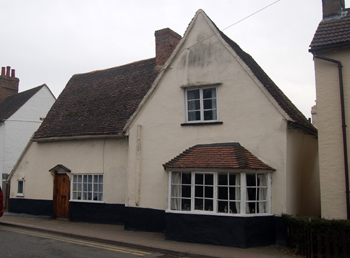The Crown Public House Great Barford
![The Crown about 1920 [Z1306-5-10-8-1]](/CommunityHistories/GreatBarford/GtBarfordImages/The Crown about 1920 [Z1306-5-10-8-1].jpg)
The Crown about 1920 [ref: Z1306/5/10/8/1]
The Crown Public House, 6 High Street, Great Barford
6 High Street, formerly the Crown Public House, was listed by the former Department of Environment in July 1964 as Grade II, of special interest. The department dated the property to the 17th century. Like most of the older properties in the village it is constructed of colour washed roughcast over a timber frame. The building has an old tiled roof and it built in a T-plan with one storey and attics. There is a lean-to addition to the east gable end and other additions to the rear, all in colour washed brick.
It is not known when the Crown first opened as a public house but it may well have been a private house before it became a public one. The first surviving record is from 1822 when the Crown was included in the countywide register of alehouse recognizances [ref: CLP13]. In 1834 it was transferred as part of the brewery business of Samuel Wells of Biggleswade to Frederick Hogg and William Lindsell [GK0/1]. The firm continued to be known as Wells & Company until 1899 when George Winch of Chatham [Kent] purchased the company for his son Edward Bluett Winch and the name changed to Wells and Winch.
In 1920 Walter Molesworth Peacock carried out a number of surveys of licensed premises in North Bedfordshire for the magistrates [ref: PK7/4/6]. One of them was the Crown, still owned by Wells and Winch and tenanted by David Minney, who had been there for twenty four years, paying £18 per annum rent. The roughcast and tiled building was categorised as “Very Old”, decorative repair as “Good” and cleanliness as “Good”.
Public accommodation comprised: a tap room measuring 12 feet 5 inches by 13 feet 5 inches; a parlour measuring 10 feet 10 inches by 9 feet 3 inches and a cellar “capable of holding 8 barrels”. Private accommodation comprised: a living room and kitchen measuring 10 feet 9 inches by 17 feet 4 inches; a washhouse fitted with a copper for heating water and a sink; three bedrooms “one in bad repair which could be made into the fourth” and a boxroom. Outbuildings consisted of: a timber and corrugated iron trap shed and meal place and a similarly constructed hen house and cart shed; a timber and tiled public closet and urinal; a timber and tiled stable with brick and corrugated iron chaff place; a timber and tiled barn and cow house for three and a brick and slate private closet. A paddock of one rood and two acres behind the Cross Public House also belonged to the house.
A letter from Biggleswade Brewery gave the trade at the Crown for the last three years. This was as follows:
- 1918: 103 barrels and 89 dozen bottles of beer; 68 gallons of spirits;
- 1919: 86 barrels and 60 dozen bottles of beer; 58 gallons of spirits;
- 1920: 77 barrels and 23 dozen bottles of beer; 89 gallons of spirits.
The Rating and Valuation Act 1925 specified that every building and piece of land in the country was to be assessed to determine its rateable value. Most of Bedfordshire was valued in 1927 and the valuer visiting the Crown [ref: DV1/C156/148] found it occupied by David Minney who paid rent of £25 per annum including the two acres of land behind the Golden Cross Public House on Bedford Road.
Accommodation comprised a tap room (“poor”), a cellar and a smoke room with a urinal and privy outside. Private accommodation consisted of a living room, pantry, three bedrooms and a boxroom. A wooden privy stood outside along with a trap house, a meal and mixing place, a hen house, a two bay open hovel, a stable for two horses, a chaff hut, a corn and chaff barn, a loose, box, a pig box, a stable for three horses and a tiled, wooden and corrugated iron implement shelter.
Trade consisted of a 36 gallon barrel of beer, two dozen bottles of beer and “say” two or three bottles of spirits per week. Cigarettes and tobacco were obtained from wholesalers Salsburys of Cauldwell Street, Bedford.
In 1961 Wells and Winch merged with Bury Saint Edmunds [Suffolk] brewer Greene King and dropped the old Wells and Winch name two years later in favour of the name of the Suffolk firm. At the time the property was first listed in 1964 it was still the Crown Inn but is now [2010] a private house.
List of Licensees: note that this is not a complete list. Italics indicate licensees whose beginning and/or end dates are not known:
1822-1853: Giles Buckle;
5 Feb 1853: John Daniels;
12 Sep 1857 - 1894: Frederick Daniels;
1896-1932: David Minney;
1932-1940: Ellen Minney

The Old Crown - 6 High Street, March 2010
List of sources at Bedfordshire Archives:
- CLP13: Register of Alehouse Recognizances: 1822-1828;
- PSB1/1: renewals of licence: 1829-1834
- GK0/1: conveyance of brewery and licensed properties of Samuel Wells of Biggleswade, brewer, deceased to Frederick Hogg and William Lindsell: 1834;
- GK1/36: three sales catalogues bound together: Wells & Company of Biggleswade 1898; Henlow Brewery 1899; Baldock Brewery Limited 1903;
- Z1039/34/2a: conveyance of licensed properties from Frederick Archdale, Charles Samuel Lindsell, Henry Martin Lindsell and Arthur Knox Lindsell to Wells & Winch: 1899;
- PSB9/1: Register of Alehouse Licences - Bedford Petty Sessional Division: 1903-1935
- Z1306/5/10/6: postcard: 1906;
- Z1306/5/10/7: postcard: 1909;
- Z1306/5/10/9: postcard: 1915;
- Z1306/5/10/8: postcard: c. 1920;
- PK7/4/6: Evidence and report given by W.M. Peacock on Great Barford licenses - including details on trade, rental and license: 1920-1921;
- PCGreatBarford30/1: transfer of licence: 1932;
- RDBP3/513: plans for alterations: 1945